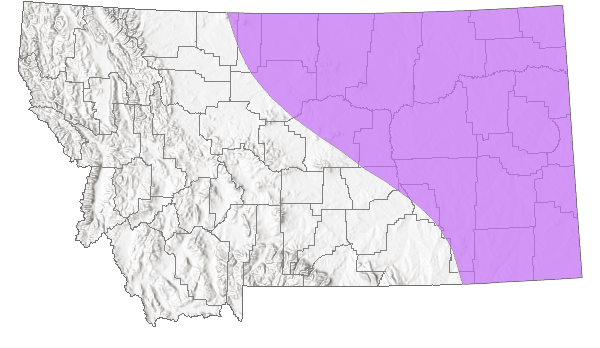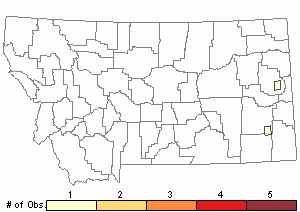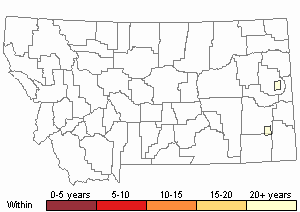View in other NatureServe Network Field Guides
NatureServe
Montana
Utah
Wyoming
Idaho
Wisconsin
British Columbia
South Carolina
Yukon
California
New York
Toothed Field Grasshopper - Trimerotropis agrestis
General Description
The following is taken from Brooks (1958), Helfer (1971), Otte (1984), Vickery and Kevan (1985), McDaniel (1987), Brust et al. (2008), and Scott (2010). This medium-sized species is sandy colored to grayish brown with scattered dark spots. The median carina (ridge) of the pronotum is obvious, but low, and cut by 2 sulci (grooves). The lateral lobe is extended to a rounded tooth at the ventral-posterior edge (see illustration). The tegmina (forewings) bear no bands and closely match sandy ground. The hindwing disk is yellow with a prominent black band, short spur, and wide transparent tip. The outerface of the hind femur is speckled with dark spots with some coalescing into larger spots. The inner face of the hind femur is reddish with the basal third being black and apical third bearing a black band. The hind tibia is red, sometimes merging into a pale area at the base.
Communicative behavior/Crepitation*
Flight is short and low to the ground. Both genders crepitate just before landing. Courting males stridulate* with 4 strokes when about 9 inches from the female and then mount for copulation. Femur-tipping sometimes proceeds before stridulation. Femur-tipping, femur shaking, and striking the ground with the hind tibia is used in male-to-male aggressive displays (Otte 1970, and Vickery and Kevan 1985).
*Crepitation is the sound produced by grasshoppers making a clicking or snapping noise with their wings when in flight, during courtship, territorial encounters or being disturbed.
*Stridulation is rubbing one body part against another, usually the hind femur against the forewing in the case of the Band-winged Grasshoppers. This is often used for attracting a female during courtship (Otte 1970).
Note: The Trimerotropis is the largest genus within the bandwing group. Ten species occur in Montana and possess considerable morphological characteristics and variations in color and markings among individuals of the same species. It is not an easy genus to identify to the species level. In addition, this genus is easily confused with other grasshopper genera (refer to “Similar species” below). However, there are certain morphological characters which can help in determining a Trimerotropis: (A) The body is elongate and slender. (B) The pronotal (thorax) carinal crest is prominent, but low, and always cut by 2 sulci (grooves) before the middle. (C) The tegmina (forewings) extend beyond the abdominal tip. (D) The disk of the hindwings is always yellow, yellow-green, or blue, never red or orange. (E) The eyes are relatively large, but not bulbus (Otte 1984, Vickery and Kevan 1985).
Phenology
The Toothed Field Grasshopper overwinters in the egg stage. Nymphs appear in early June and adults occur from July to August, sometimes into September (Otte 1984, Vickery and Kevan 1985, Brust et al. 2008, and Scott 2010).
Diagnostic Characteristics
The following comes from Brooks (1958), Helfer (1971), Otte (1984), Vickery and Kevan (1985), McDaniel (1987), Brust et al. (2008), and Scott (2010). The body length to end of forewings for males is 24-43 mm, and for females 31-43 mm. The lower posterior angle of pronotum lateral lobe is extended to a rounded point, thus, its common name (see illustration).
This species is easily confused with other Trimerotropis species, and other Montana species in the genera such as Spharagemon, Derotmema, Circotettix, and Mestobregma (Scott 2010 and field notes).
Species Range
Montana Range
Range Descriptions

 Native
Native
Range Comments
This species range is from the north in southern Alberta, Saskatchewan, and Manitoba, southward to New Mexico. East of the Rocky Mountain front Montana, Wyoming, Colorado and New Mexico, eastward to western South Dakota, Nebraska, Kansas, and the panhandle of Oklahoma. In Montana, it has been reported for 3 counties. This species is probably quite rare in the state, considering its habitat preference (Otte 1984, Vickery and Kevan 1985, and Scott 2010).
Observations in Montana Natural Heritage Program Database
Number of Observations: 2
(Click on the following maps and charts to see full sized version)
Map Help and Descriptions
Relative Density

Recency


 (Observations spanning multiple months or years are excluded from time charts)
(Observations spanning multiple months or years are excluded from time charts)
Habitat
Inhabits sandy habitats with sparse vegetation, such as dunes, hillsides, and blowouts (Otte 1984, and Vickery and Kevan 1985).
Food Habits
Not well known but has been noted to feed on Pediomelum sp. (formally Psoralea sp.), and a mixture of grasses, forbs, and dead or dying insects (Brust et al. 2008).
Reproductive Characteristics
No studies have currently been found in the literature.
Stewardship Responsibility
References
- Literature Cited AboveLegend:
 View Online Publication
View Online Publication Brooks, A.R. 1958. Acridoidea of Southern Alberta, Saskatchewan, and Manitoba (Orthoptera). The Canadian Entomologist (Supplement 9) 90:5-92.
Brooks, A.R. 1958. Acridoidea of Southern Alberta, Saskatchewan, and Manitoba (Orthoptera). The Canadian Entomologist (Supplement 9) 90:5-92. Brust, M.L, W.W. Hoback, and R.J. Wright. 2008. The Grasshoppers of Nebraska. Lincoln, NB: University of Nebraska Extension Service, APHIS.
Brust, M.L, W.W. Hoback, and R.J. Wright. 2008. The Grasshoppers of Nebraska. Lincoln, NB: University of Nebraska Extension Service, APHIS. Helfer, J.R. 1971. How to Know the Grasshoppers, Crickets, Cockroaches, and Their Allies. Revised edition (out of print), Mineola, NY: Dover Publications.
Helfer, J.R. 1971. How to Know the Grasshoppers, Crickets, Cockroaches, and Their Allies. Revised edition (out of print), Mineola, NY: Dover Publications. McDaniel, B. 1987. Grasshoppers of South Dakota. Brookings, SD: South Dakota Agricultural Experiment Station, Bulletin TB 89.
McDaniel, B. 1987. Grasshoppers of South Dakota. Brookings, SD: South Dakota Agricultural Experiment Station, Bulletin TB 89. Otte, Daniel. 1970. A comparative study of communicative behavior in grasshoppers. Miscellaneous Publications, Museum of Zoology, No. 141. Ann Arbor, MI: University of Michigan.
Otte, Daniel. 1970. A comparative study of communicative behavior in grasshoppers. Miscellaneous Publications, Museum of Zoology, No. 141. Ann Arbor, MI: University of Michigan. Otte, Daniel. 1984. The North American Grasshoppers Volume II. Acrididae (Oedipodinae). Harvard University Press. 366 pp.
Otte, Daniel. 1984. The North American Grasshoppers Volume II. Acrididae (Oedipodinae). Harvard University Press. 366 pp. Scott, R.D. 2010. Montana Grasshoppers, Katydids, and Crickets A Pictorial Field Guide to the Orthoptera. MagpieMTGraphics, Billings, MT.
Scott, R.D. 2010. Montana Grasshoppers, Katydids, and Crickets A Pictorial Field Guide to the Orthoptera. MagpieMTGraphics, Billings, MT. Scott, Ralph. Personal field notes. 2018.
Scott, Ralph. Personal field notes. 2018. Vickery, V. R. and D. K. M. Kevan. 1985. The grasshopper, crickets, and related insects of Canada and adjacent regions. Biosystematics Research Institute, Ottawa, Ontario. Publication Number 1777. 918 pp.
Vickery, V. R. and D. K. M. Kevan. 1985. The grasshopper, crickets, and related insects of Canada and adjacent regions. Biosystematics Research Institute, Ottawa, Ontario. Publication Number 1777. 918 pp.
- Additional ReferencesLegend:
 View Online Publication
View Online Publication
Do you know of a citation we're missing? Capinera, J.L., R.D. Scott, and T.J. Walker. 2004. Field Guide to Grasshoppers, Katydids, and Crickets of the United States. Ithaca, NY. Cornell University Press.
Capinera, J.L., R.D. Scott, and T.J. Walker. 2004. Field Guide to Grasshoppers, Katydids, and Crickets of the United States. Ithaca, NY. Cornell University Press. Hebard, M. 1928. The Orthoptera of Montana. Proceedings of the Academy of Natural Sciences of Philadelphia, Vol. 80:211-306.
Hebard, M. 1928. The Orthoptera of Montana. Proceedings of the Academy of Natural Sciences of Philadelphia, Vol. 80:211-306. Otte, D. 1977. Communication in Orthoptera In: Sebeok, T.A. (ed). How animals communicate. Bloomington, ID: Indiana University Press. 1128 p.
Otte, D. 1977. Communication in Orthoptera In: Sebeok, T.A. (ed). How animals communicate. Bloomington, ID: Indiana University Press. 1128 p. Richman, D.B., D.C. Lightfoot, C.A. Sutherland, and D.J. Ferguson. 1993. A manual of the grasshoppers of New Mexico. Las Cruces, NM: Cooperative Extension Service, Handbook No. 7.
Richman, D.B., D.C. Lightfoot, C.A. Sutherland, and D.J. Ferguson. 1993. A manual of the grasshoppers of New Mexico. Las Cruces, NM: Cooperative Extension Service, Handbook No. 7.
- Web Search Engines for Articles on "Toothed Field Grasshopper"
- Additional Sources of Information Related to "Insects"





